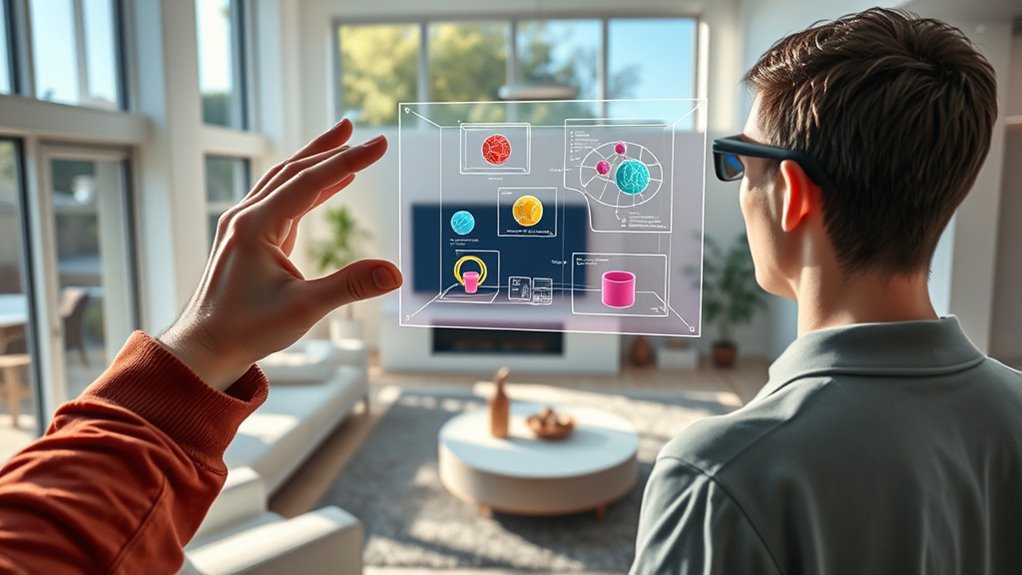Spatial computing combines digital data with your physical environment, making interactions more seamless. It uses tools like augmented reality (AR) to overlay virtual objects onto real-world views, enhancing tasks like navigation, shopping, or learning. With smartphones, AR glasses, or tablets, you can experience virtual furniture placement or virtual tours in your space. As technology evolves, it’s transforming everyday activities. Keep exploring how these innovative tools can become part of your daily routine.
Key Takeaways
- Spatial computing blends physical spaces with digital data using technologies like AR to enhance real-world interactions.
- Augmented reality projects virtual objects onto real environments via smartphones, tablets, or AR glasses.
- Virtual environments allow users to explore, modify, and interact with digital spaces for training, gaming, or virtual tours.
- These technologies make digital information more accessible and intuitive, transforming daily tasks and communication.
- The future of spatial computing promises seamless integration of digital and physical worlds for more natural experiences.

Spatial computing is transforming the way we interact with digital environments by blending physical space with virtual data. Instead of staring at screens disconnected from real life, you now have the power to overlay digital information directly onto your surroundings. This integration is possible through technologies like augmented reality (AR), which enhances your view of the world by adding virtual objects and data in real time. When you use AR, you can see digital images, information, or even 3D models as if they’re part of your physical environment. This creates a seamless experience where virtual environments feel more natural and immediate, making everyday tasks more engaging and efficient.
Imagine walking into your living room and seeing virtual furniture placed where you want to arrange new pieces, or trying on virtual clothes without leaving your home. Augmented reality makes these experiences possible by projecting digital content onto your real-world view through smartphones, tablets, or AR glasses. You’re not just passively observing; instead, you’re actively interacting with these virtual elements as if they exist alongside the physical objects around you. This interaction bridges the gap between the digital and physical worlds, making information more accessible and intuitive.
Virtual environments play a vital role in helping you navigate and manipulate digital content within your space. These are fully immersive or semi-immersive digital worlds that you can explore or modify as if they’re real. For example, in training simulations or virtual tours, you can move around and interact with virtual objects just like you would in real life. This type of spatial computing fosters a sense of presence, allowing you to learn, work, or entertain yourself within a digital space that feels tangible. As the technology advances, virtual environments are becoming more realistic and responsive, providing a richer experience that enhances productivity and creativity.
You might not realize it, but these tools are becoming part of your daily life. Whether you’re using AR to get directions, trying out virtual products before buying, or exploring new virtual environments for entertainment, spatial computing is shaping your interaction with digital content. It’s about making digital data more intuitive, accessible, and integrated into the physical world. As these technologies evolve, they’ll continue to transform how you communicate, work, learn, and play, all by merging the physical and virtual into a single, seamless experience. The future of spatial computing is here, and it’s making digital interactions more natural, engaging, and useful than ever before. Additionally, understanding the fundamentals of spatial computing can help you better grasp how these innovations can be integrated into everyday life.
Frequently Asked Questions
How Secure Is Spatial Computing Data?
Spatial computing data’s security depends on the measures in place. Typically, your data is protected through data encryption, which makes it unreadable to unauthorized users. However, your user privacy can vary based on app permissions and platform policies. To stay safe, always review privacy settings and make certain encryption is used. While the technology offers strong protections, staying vigilant helps keep your spatial computing data secure.
Can Spatial Computing Be Used Outdoors Effectively?
Yes, spatial computing works effectively outdoors, especially with augmented reality and outdoor navigation. Did you know that over 60% of users find AR-based navigation more engaging and accurate in open environments? You’ll find that GPS and sensor technology have advanced, making outdoor spatial computing seamless. Whether exploring new places or using AR for real-world tasks, spatial computing enhances your outdoor experience by providing real-time, location-based information effortlessly.
What Are the Beginner-Friendly Spatial Computing Devices?
If you’re new to spatial computing, beginner-friendly devices include AR glasses like Microsoft HoloLens and Oculus Quest. These devices let you explore augmented reality and virtual environments easily, offering immersive experiences without complicated setups. They’re perfect for learning, gaming, or trying out virtual environments. With simple interfaces and user-friendly designs, you can quickly get started and enjoy the benefits of spatial computing in your daily life.
How Does Spatial Computing Impact Privacy?
Imagine a transparent shield around you—spatial computing influences your privacy by raising concerns about data protection and surveillance. As you use these devices, your movements and surroundings might be recorded, creating potential privacy issues. You need to stay vigilant, understanding how your personal information is collected and used. Ensuring proper privacy settings and being aware of data sharing helps protect your digital space from unwelcome intrusions.
Is Spatial Computing Suitable for Children?
Yes, spatial computing can be suitable for children when it includes child-friendly features and educational applications. You should look for platforms that prioritize safety, offer age-appropriate content, and have parental controls. These features help guarantee your child learns and plays in a secure environment. When used responsibly, spatial computing can enhance your child’s learning experience and creativity, making technology both fun and educational.
Conclusion
As you explore spatial computing, you’ll notice how seamlessly it integrates into daily life, almost like it was meant to be there all along. Sometimes, the world aligns perfectly—digital and physical merging in unexpected ways—reminding you how technology quietly shapes your experiences. By understanding its basics, you’re not just a user but a participant in this evolving space. It’s no coincidence; this intersection of reality and innovation is where the future quietly begins.









